

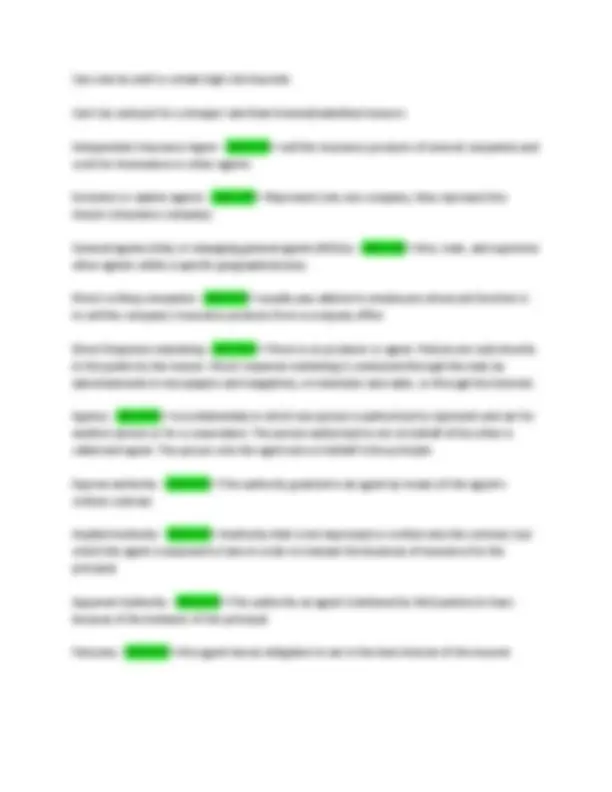
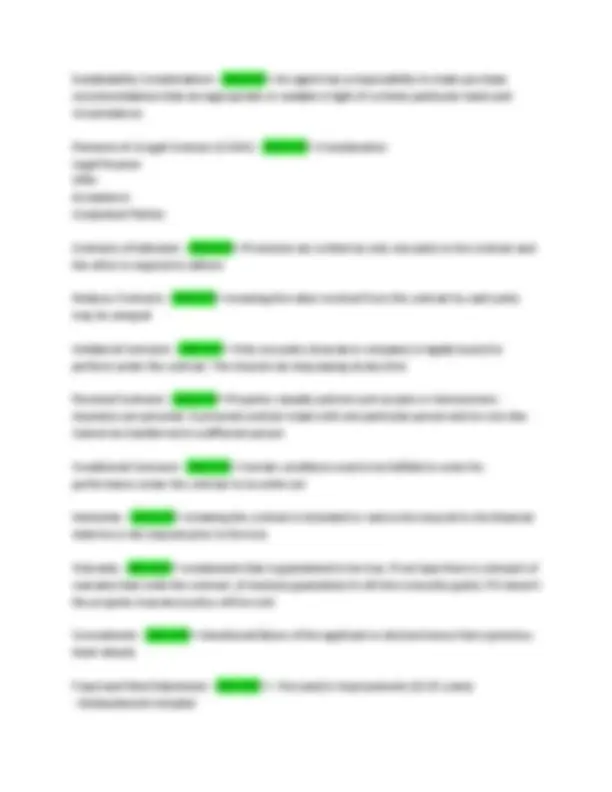
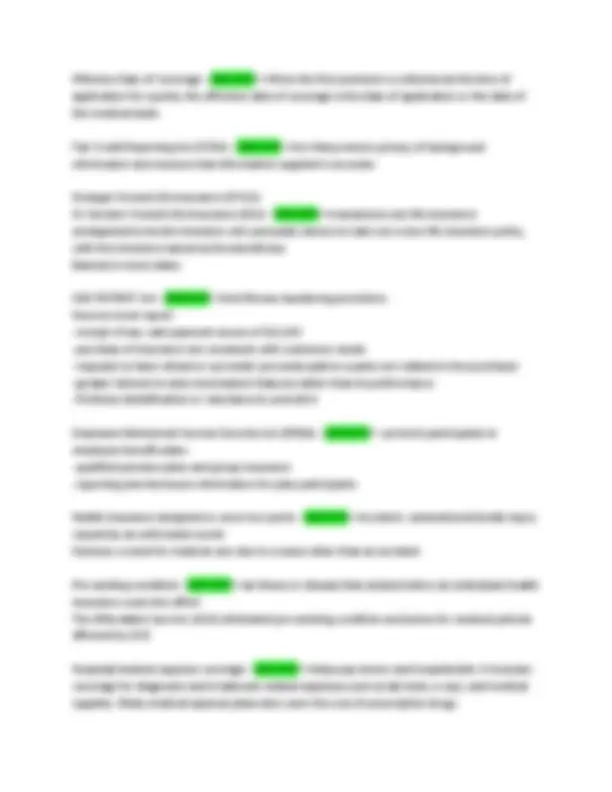
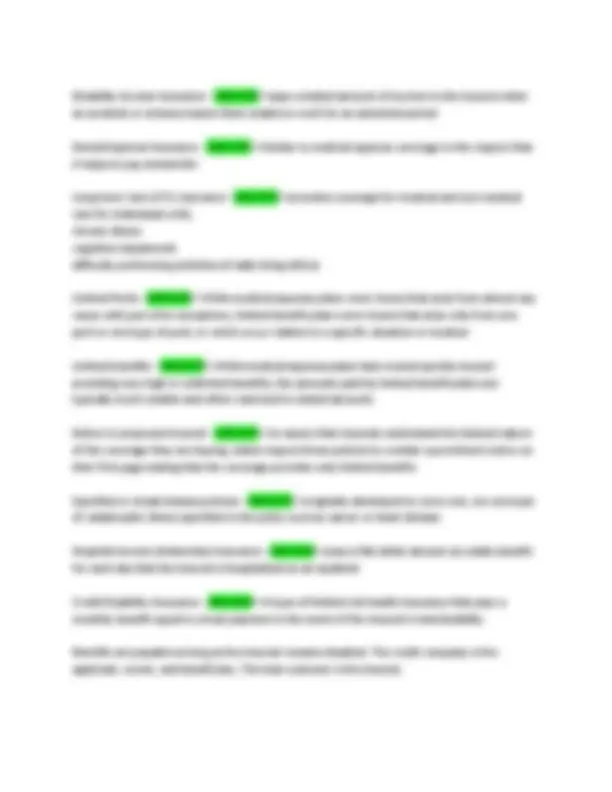
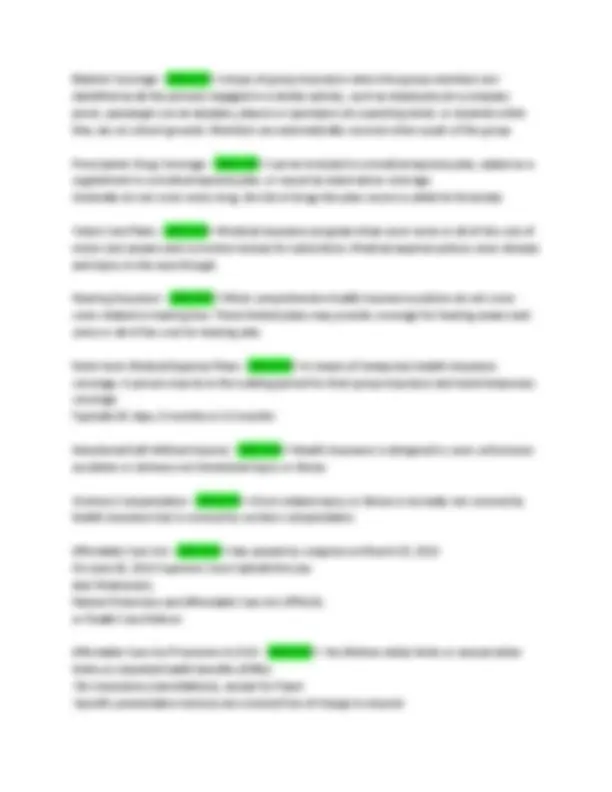
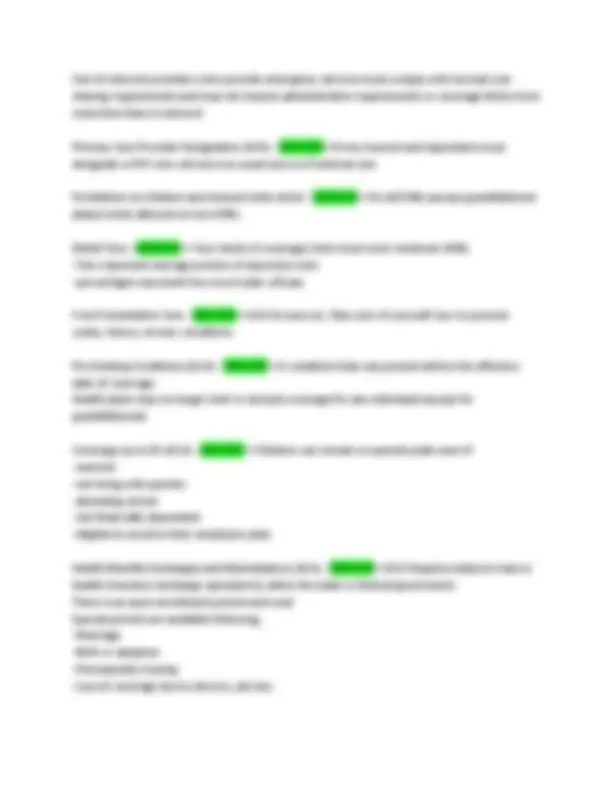
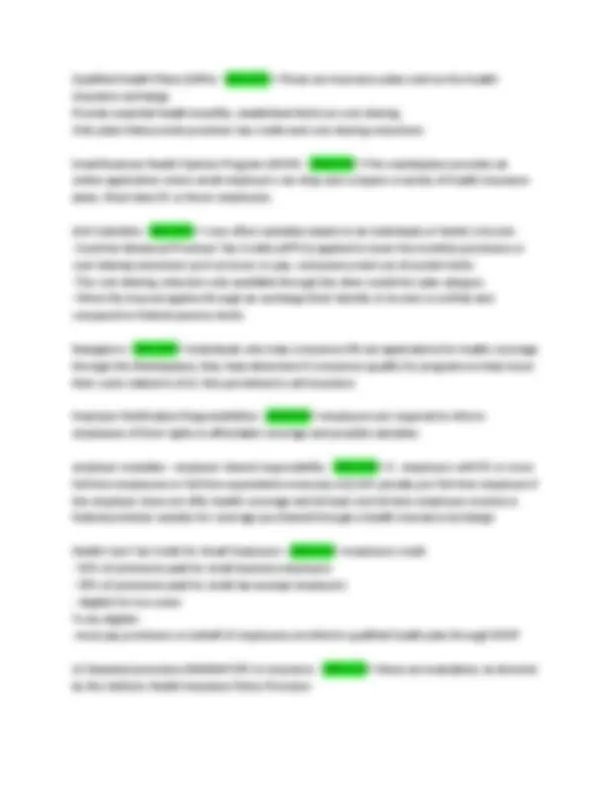
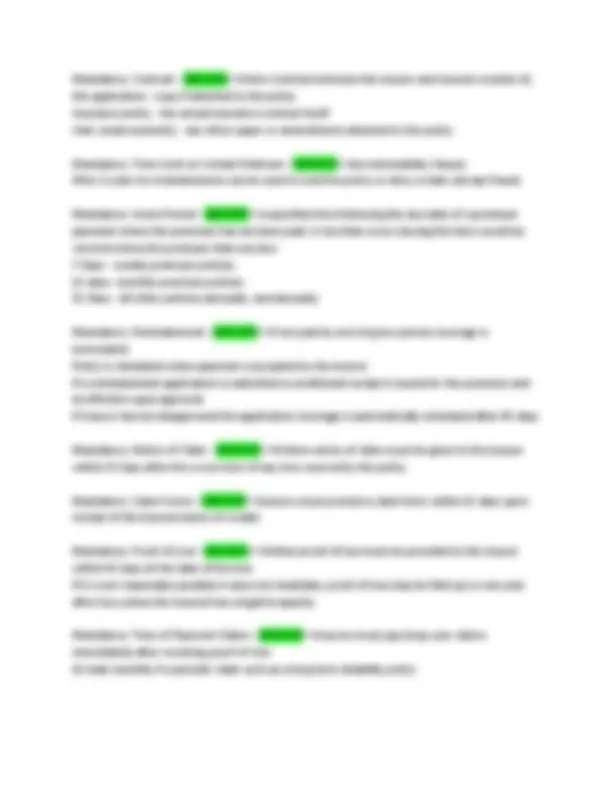
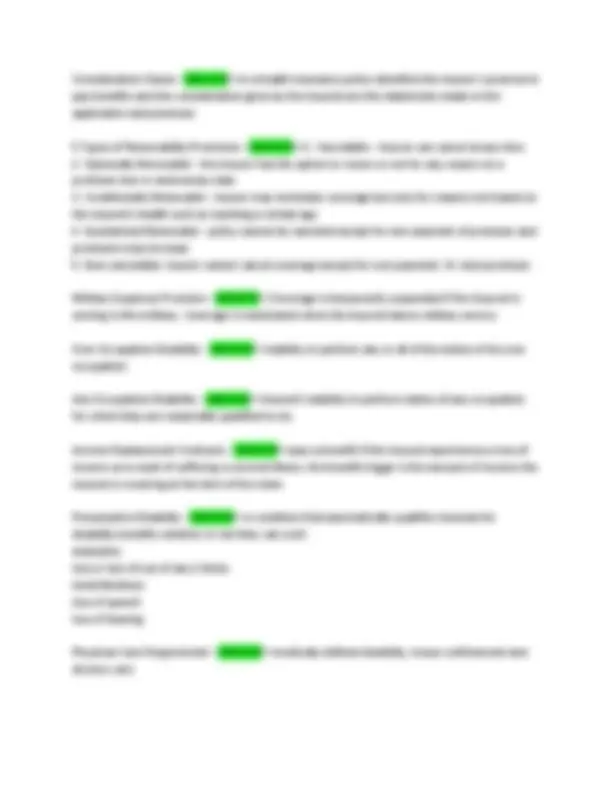

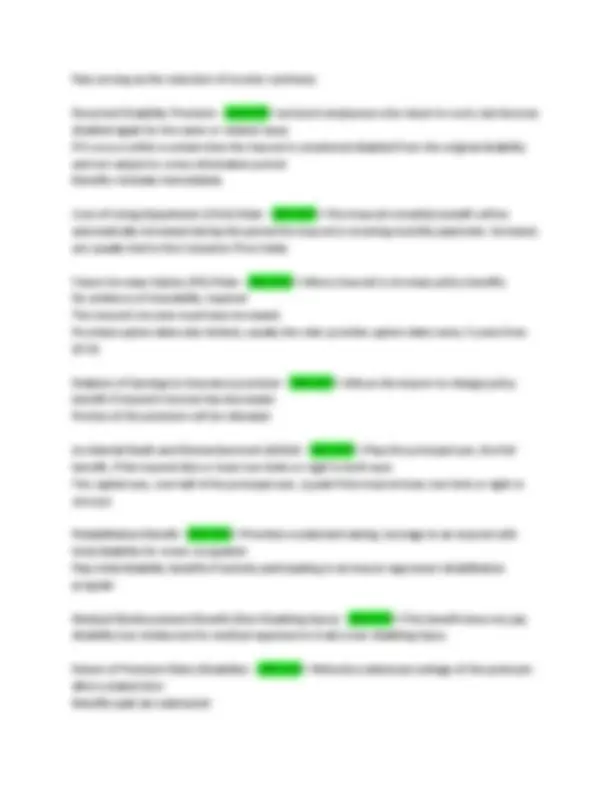
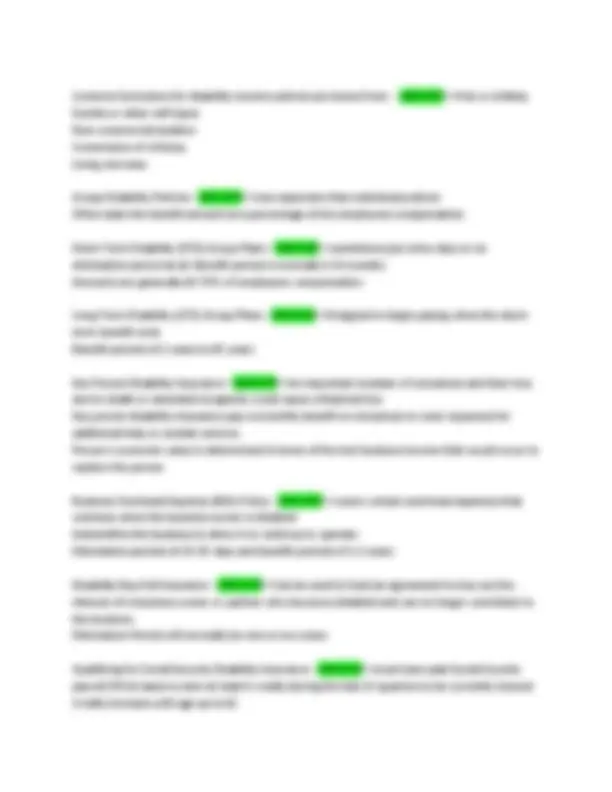
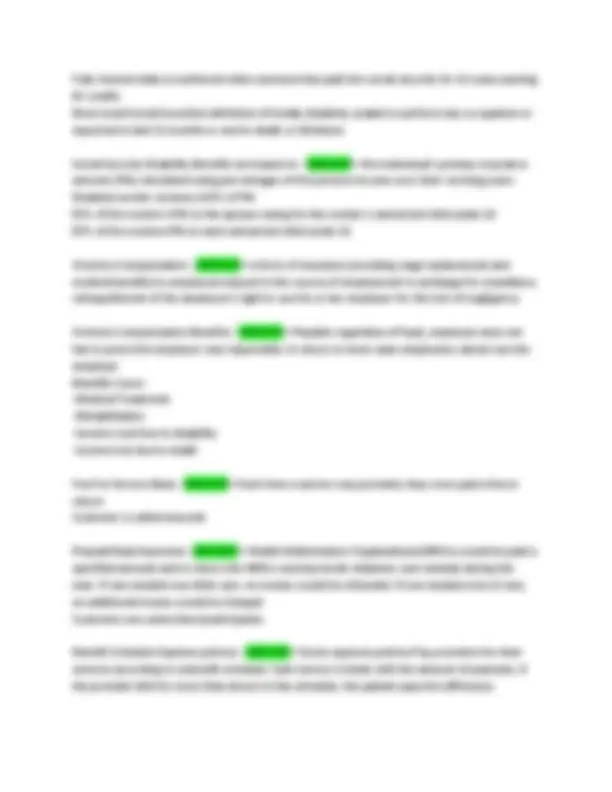
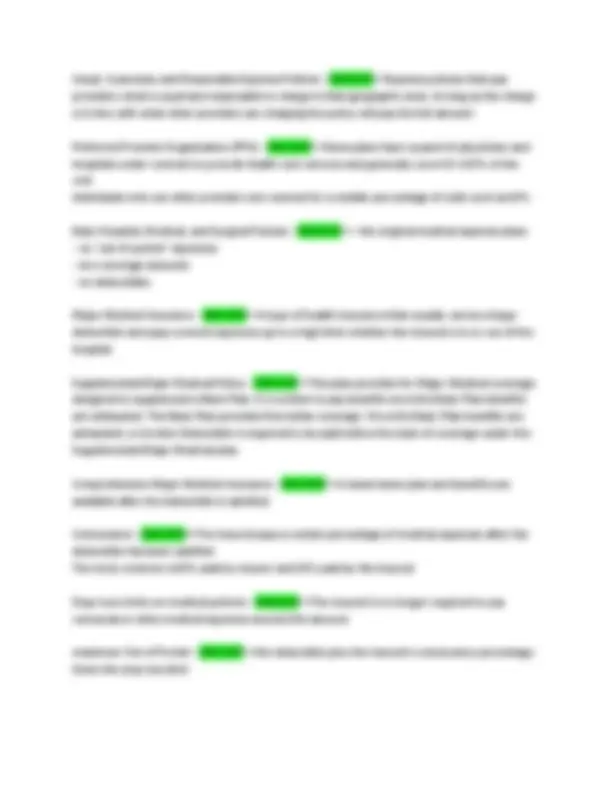
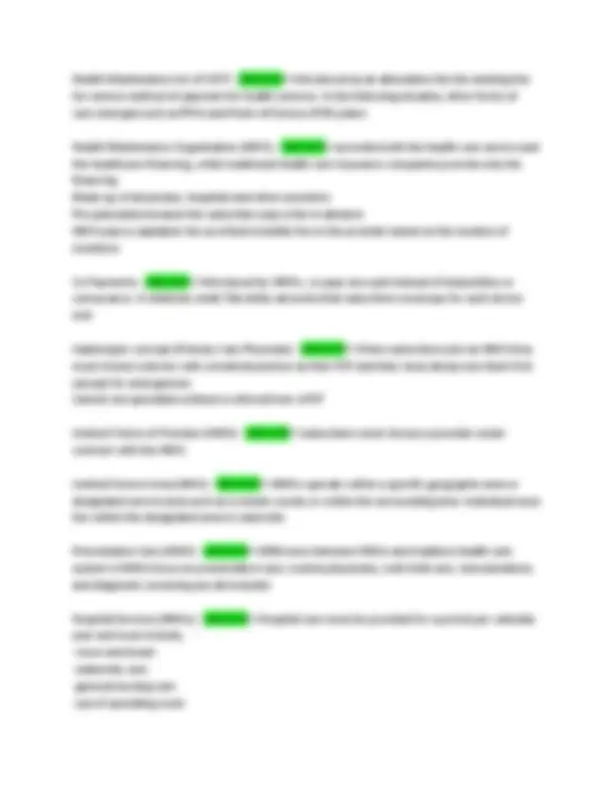
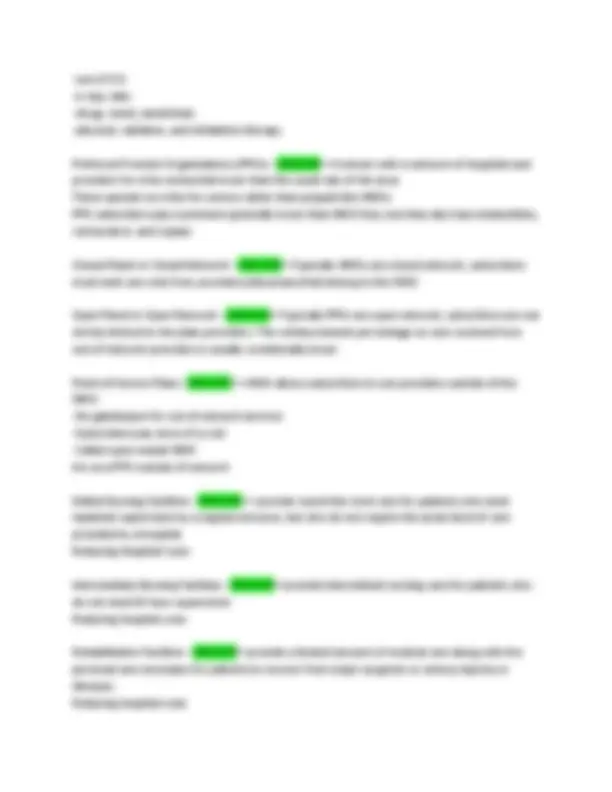
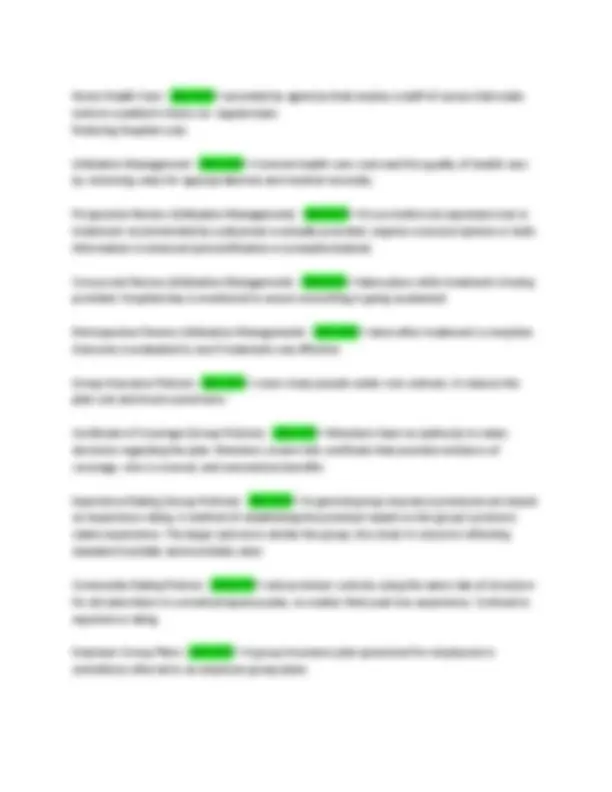
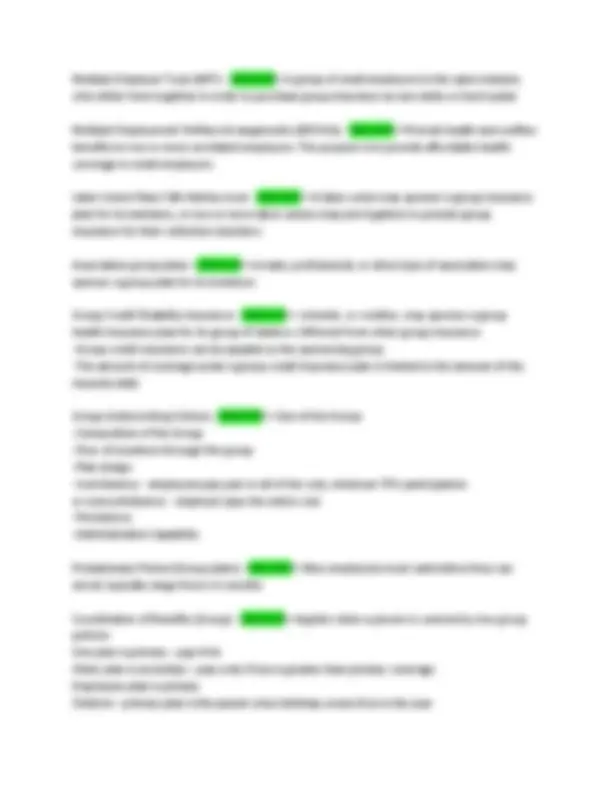
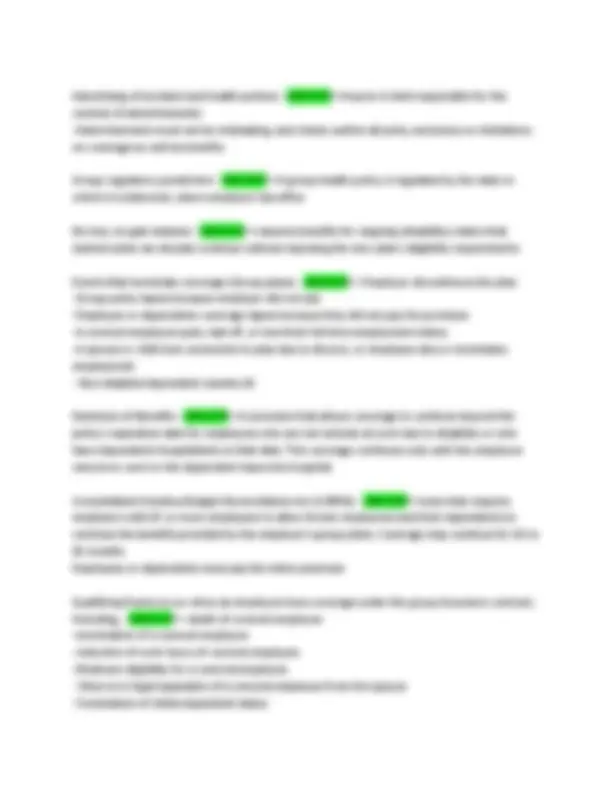

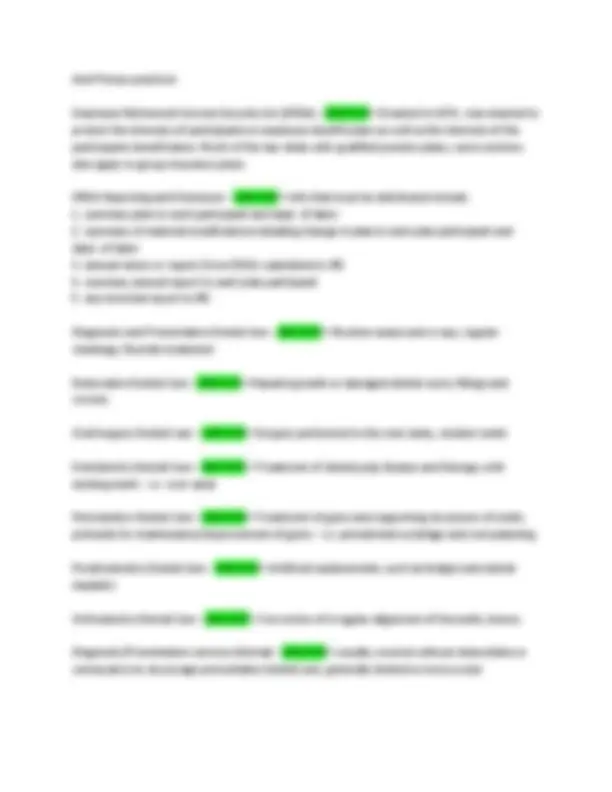
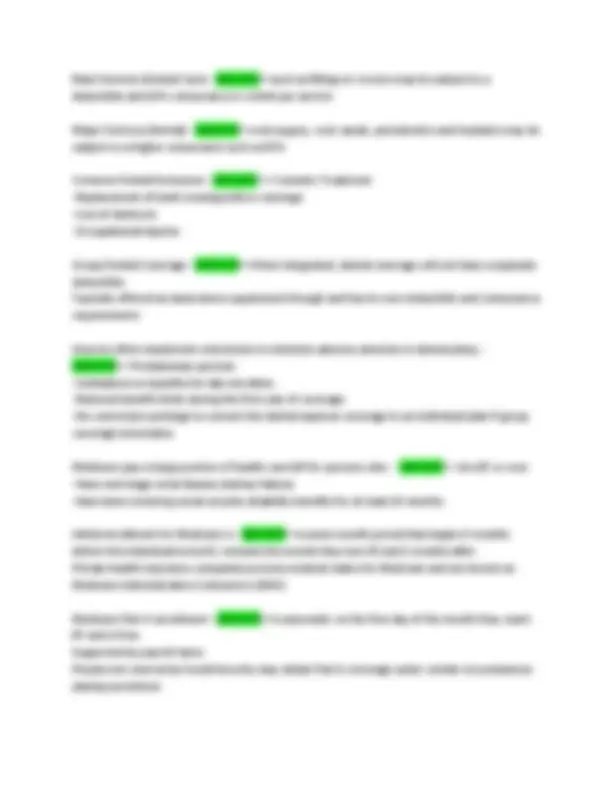
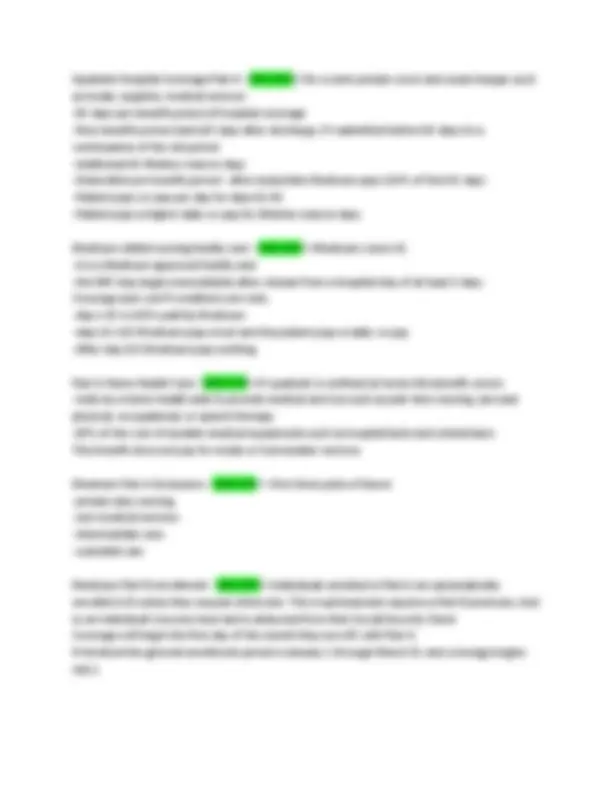
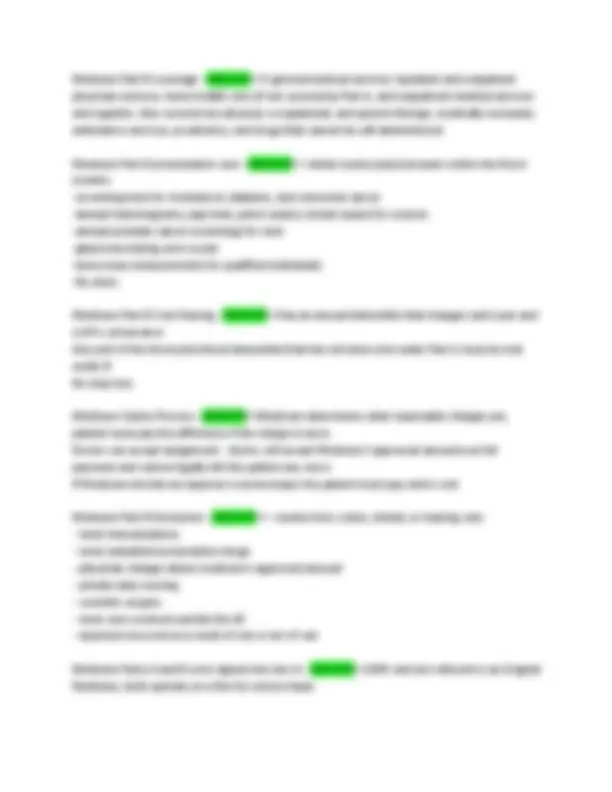
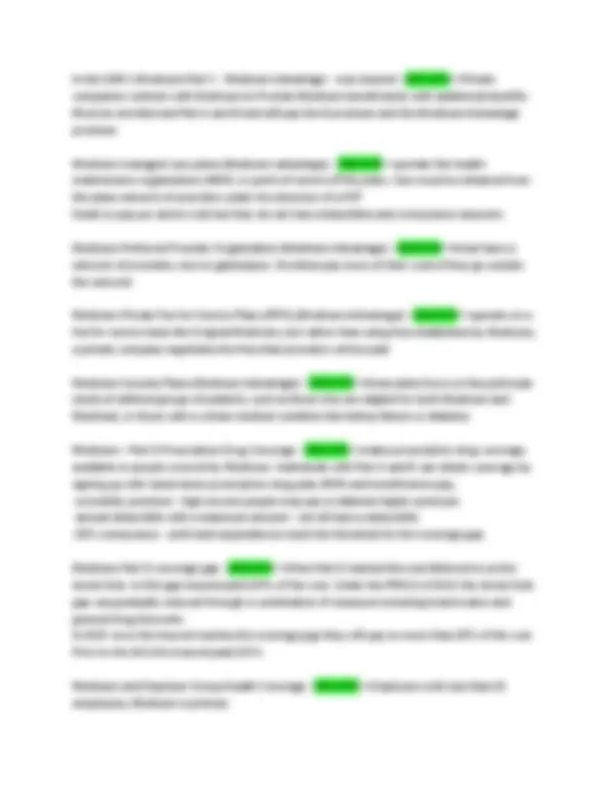
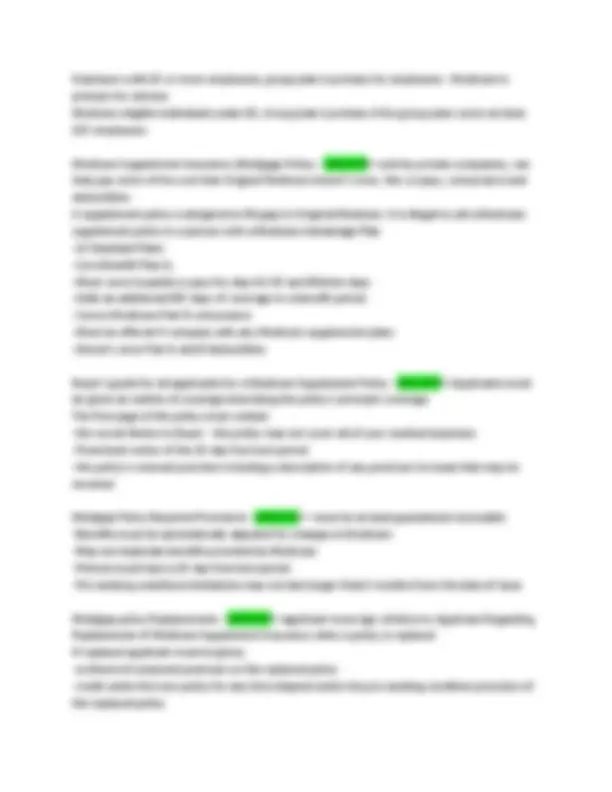
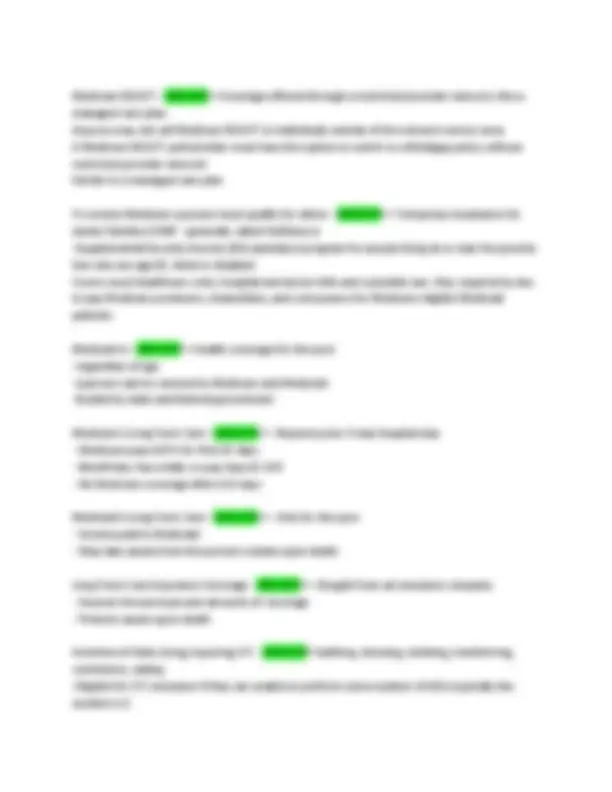
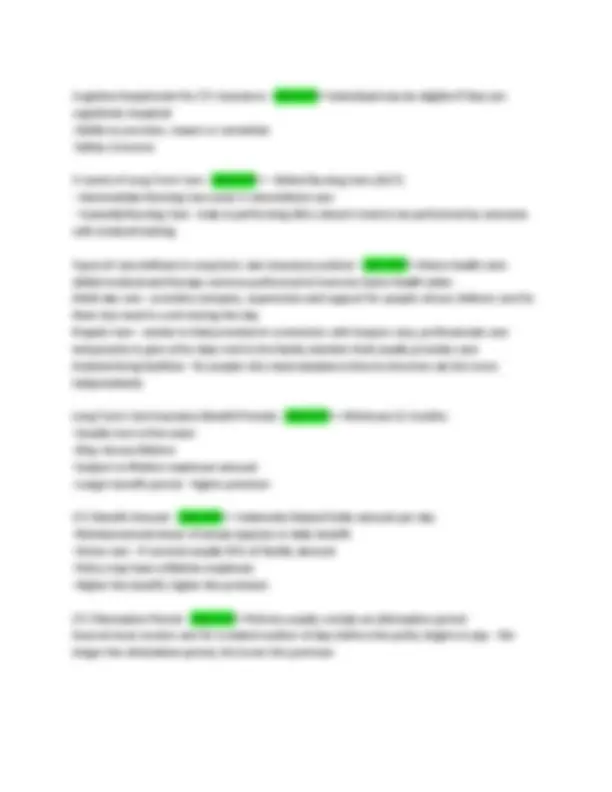
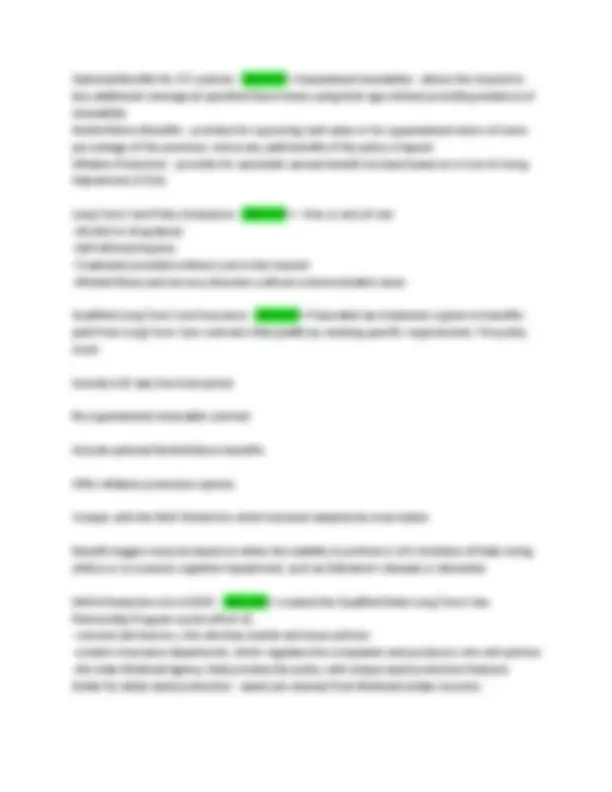
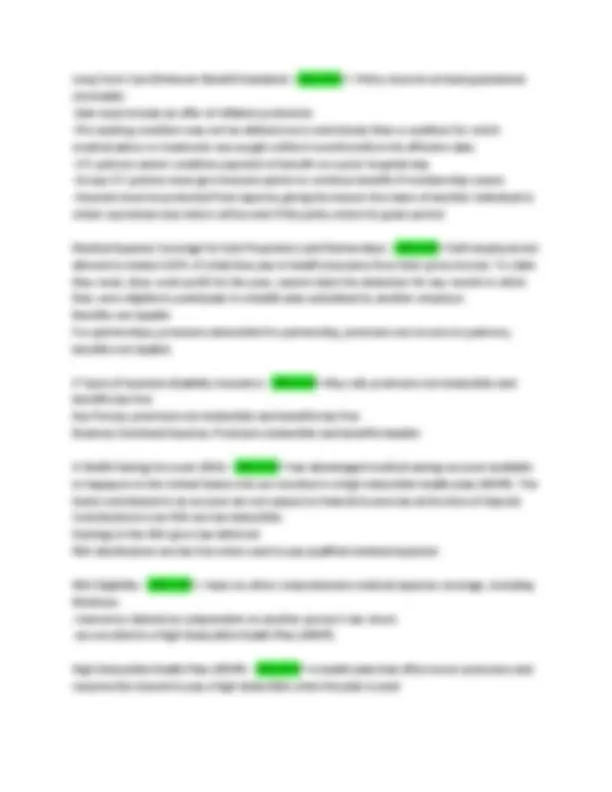
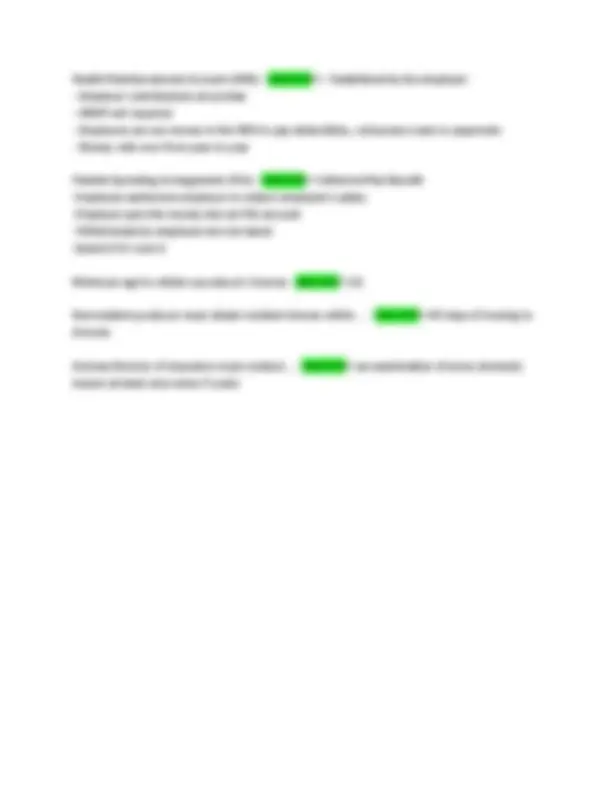


Study with the several resources on Docsity

Earn points by helping other students or get them with a premium plan


Prepare for your exams
Study with the several resources on Docsity

Earn points to download
Earn points by helping other students or get them with a premium plan
Community
Ask the community for help and clear up your study doubts
Discover the best universities in your country according to Docsity users
Free resources
Download our free guides on studying techniques, anxiety management strategies, and thesis advice from Docsity tutors
Arizona Health Insurance Exam questions and answers.
Typology: Exams
1 / 40

This page cannot be seen from the preview
Don't miss anything!

































Insurance - ANSWER>>A contract that transfers the risk of financial loss from an individual or business to an insurer. In return the insurer agrees to cover the individual or business for certain losses if they occur
Risk - ANSWER>>Is uncertainty about whether a loss will occur. Insurance is designed to cover only losses that involve risk
Speculative Risk - ANSWER>>Have a possibility of a loss and also hold the possibility of making a gain. Companies will not insure because you could win or lose (Gambling losses or investments)
Pure Risks - ANSWER>>only involve the possibility of experiencing a loss and they can be covered by insurance (Car accident)
Loss is a... - ANSWER>>reduction in the value of an asset.
To determine the amount of a loss, - ANSWER>>The value of the asset is measured before and after the loss. (Before - After Loss = Total loss)
Exposure - ANSWER>>is the risk assumed by an insurer and the amount that the insurer is responsible to pay out at any given time. Exposure is expressed in units
Calculation for Insurance Premiums - ANSWER>>Is the rate multiplied by the number of exposure units. (If the life insurance rate is $32 per $1,000 of death benefit, the premium for a $100,000 policy would be $32 x $100 = $3,
A peril - ANSWER>>A cause of a loss (house burning down, peril is fire)
Physical Hazard - ANSWER>>physically identifiable factors that increase the chance of loss (heart condition)
Moral Hazard - ANSWER>>Dishonesty is a moral hazard because it increases the chance that an individual might lie on an insurance application or fake a loss
Morale Hazard - ANSWER>>an unconscious change in a persons actions or behaviors, versus a deliberate change with the intent to cheat or benefit from such circumstances (leaving door unlocked)
STARR (handling risk) - ANSWER>>Sharing Transfer Avoidance Reduction Retention
Sharing - ANSWER>>In risk sharing, two or more individuals agree to pay a portion of any loss incurred by any member in the group (Stockholders)
Transfer - ANSWER>>Transfer of risk is what happens with insurance. The insurer agrees to pay if an individual or business has a loss
Avoidance - ANSWER>>Risk avoidance means eliminating a particular risk by not engaging in a certain activity
Reduction - ANSWER>>Risk reduction may refer to lessening the chance that a loss will occur, or to lessening the extent of a loss that does occur (seatbelts)
Retention - ANSWER>>Risk retention means the individual will pay for the loss if it occurs
Adverse Selection - ANSWER>>the tendency for higher-risk individuals to get and keep insurance more than individuals who represent an average level of risk
Reinsurance - ANSWER>>an insurance company (the ceding company) paying another insurance company (reinsurer) to take some of the companies risk of catastrophic loss
Facultative Reinsurance - ANSWER>>The reinsurer considers each risk before allowing the transfer to be made from the ceding company
Treaty Reinsurance - ANSWER>>the reinsurer accepts all risks of a certain type from the ceding company
Stock insurers - ANSWER>>a corporation owned by stockholders
Can only be sold to certain high risk insureds
Can't be sold just for a cheaper rate than licensed/admitted insurers
Independent Insurance Agent - ANSWER>>sell the insurance products of several companies and work for themselves or other agents
Exclusive or captive agents - ANSWER>>Represent only one company, they represent the insurer (insurance company)
General agents (GAs) or managing general agents (MGAs) - ANSWER>>hire, train, and supervise other agents within a specific geographical area.
Direct-writing companies - ANSWER>>usually pay salaries to employees whose job function is to sell the company's insurance products from a company office
Direct Response marketing - ANSWER>>There is no producer or agent. Policies are sold directly to the public by the insurer. Direct response marketing is conducted through the mail, by advertisements in newspapers and magazines, on television and radio, or through the internet.
Agency - ANSWER>>is a relationship in which one person is authorized to represent and act for another person or for a corporation. The person authorized to act on behalf of the other is called and agent. The person who the agent acts on behalf is the principle
Express authority - ANSWER>>The authority granted to an agent by means of the agent's written contract.
Implied Authority - ANSWER>>Authority that is not expressed or written into the contract, but which the agent is assumed to have in order to transact the business of insurance for the principal.
Apparent Authority - ANSWER>>The authority an agent is believed by third parties to have because of the behavior of the principal.
Fiduciary - ANSWER>>the agent has an obligation to act in the best interest of the insured
Sustainability Considerations - ANSWER>>An agent has a responsibility to make purchase recommendations that are appropriate or suitable in light of a clients particular needs and circumstances
Elements of a Legal Contract (CLOAC) - ANSWER>>Consideration Legal Purpose Offer Acceptance Competent Parties
Contracts of Adhesion - ANSWER>>Provisions are written by only one party to the contract and the other is required to adhere
Aleatory Contracts - ANSWER>>meaning the value received from the contract by each party may be unequal
Unilateral Contracts - ANSWER>>Only one party (Insurance company) is legally bound to perform under the contract. The insured can stop paying at any time
Personal Contracts - ANSWER>>Property-casualty policies such as auto or homeowners insurance are personal. A personal contract made with one particular person and no one else. Cannot be transferred to a different person
Conditional Contracts - ANSWER>>Certain conditions need to be fulfilled in order for performance under the contract to be enforced
Indemnity - ANSWER>>meaning the contract is intended to restore the insured to the financial state he or she enjoyed prior to the loss
Warranty - ANSWER>>a statement that is guaranteed to be true. If not kept there is a breach of warranty that voids the contract. (A business guarantees it will hire a security guard, if it doesn't the property insurance policy will be void
Concealment - ANSWER>>intentional failure of the applicant to disclose known facts (previous heart attack)
Fraud and False Statements - ANSWER>>- Fine and/or imprisonment (10-15 years)
Attending Physicians Statement (APS) - ANSWER>>From insured's regular doctor to find out about current condition and medical history
Medical Information Bureau (MIB) - ANSWER>>Non-profit insurance trade association that maintains underwriting information on applicants. Unfavorable info on an applicant is reported to MIB and other companies will already have this info
Investigative Consumer Reports (Inspection Reports) - ANSWER>>reports containing information obtained by interviewing individuals who know something about the consumer such as associates, friends, and neighbors
Standard Risks - ANSWER>>mean average health and normal life expectancy and fall into the normal range anticipated by the company when it established its premiums. These risks can be insured for standard rates.
Preferred Risks - ANSWER>>Represent excellent health
A risk of loss that is below average and therefore favorable to the company
Favorable risk factors include such things as healthy lifestyle, clean medical history, or low-risk occupation
These risks may be insured at preferred or discounted rates
Substandard Risks - ANSWER>>represent below average life expectancy, high-risk life insurance. A risk of loss is above average and unfavorable to the company. Poor health, dangerous occupation, or risky habits. Can only be accepted by charging higher rates Rated up
Declined - ANSWER>>An applicant is not insurable at any price
Agent Delivery - ANSWER>>Will usually get a signed receipt on delivery to the policy owner
Statement of good health - ANSWER>>The statement required to be signed by the applicant upon policy delivery to attest their health is the same as when they applied
Effective Date of Coverage - ANSWER>>When the first premium is collected at the time of application for a policy the effective date of coverage is the date of application or the date of the medical exam.
Fair Credit Reporting Act (FCRA) - ANSWER>>Act that protects privacy of background information and ensures that information supplied is accurate.
Stranger Owned Life Insurance (STOLI) Or Investor-Owned Life Insurance (IOLI) - ANSWER>>transactions are life insurance arrangements involve investors who persuade seniors to take out a new life insurance policy, with the investors named as the beneficiary Banned in most states
USA PATRIOT Act - ANSWER>>Anti-Money laundering provisions Insurers must report: -receipt of any cash payment excess of $10, -purchase of insurance not consistent with customers needs -requests to have refund or surrender proceeds paid to a party not related to the purchaser -greater interest in early termination features rather than its performance -Fictitious identification or reluctance to provide it
Employee Retirement Income Security Act (ERISA) - ANSWER>>-protects participants in employee benefit plans -qualified pension plans and group insurance -reporting and disclosure information for plan participants
Health insurance designed to cover two perils - ANSWER>>Accident: unintentional bodily injury caused by an unforeseen event Sickness: a need for medical care due to a cause other than an accident
Pre-existing condition - ANSWER>>an illness or disease that existed before an individuals health insurance went into effect The Affordable Care Act (ACA) eliminated pre existing condition exclusions for medical policies affected by ACA
Hospital/medical expense coverage - ANSWER>>helps pay doctor and hospital bills. It includes coverage for diagnostic and treatment-related expenses such as lab tests, x-rays, and medical supplies. Many medical expense plans also cover the cost of prescription drugs.
Blanket Coverage - ANSWER>>a type of group insurance where the group members are identified as all the persons engaged in a similar activity, such as employees at a company picnic, passengers on an airplane, players or spectators at a sporting event, or students while they are on school grounds. Members are automatically covered when a part of the group
Prescription Drug Coverage - ANSWER>>can be included in a medical expense plan, added as a supplement to a medical expense plan, or issued as stand-alone coverage. Generally do not cover every drug, the list of drugs the plan covers is called its formulary
Vision Care Plans - ANSWER>>Medical insurance programs that cover some or all of the cost of vision care (exams and corrective lenses) for subscribers. Medical expense polices cover disease and injury to the eyes though.
Hearing Insurance - ANSWER>>Most comprehensive health insurance policies do not cover costs related to hearing loss. These limited plans may provide coverage for hearing exams and some or all of the cost for hearing aids.
Short-term Medical Expense Plans - ANSWER>>A means of temporary health insurance coverage. A person may be in the waiting period for their group insurance and need temporary coverage Typically 90 days, 6 months or 12 months
Intentional Self-Inflicted Injuries - ANSWER>>Health insurance is designed to cover unforeseen accidents or sickness not intentional injury or illness
Workers Compensation - ANSWER>>Work related injury or illness is normally not covered by health insurance but is covered by workers compensation
Affordable Care Act - ANSWER>>law passed by congress on March 23, 2010 On June 28, 2012 Supreme Court Upheld the Law also Obamacare, Patient Protection and Affordable Care Act (PPACA) or Health Care Reform
Affordable Care Act Provisions in 2010 - ANSWER>>-No lifetime dollar limits or annual dollar limits on essential health benefits (EHBs) -No rescissions (cancellations), except for fraud -Specific preventative services are covered free of charge to insured
-Dependent coverage until a child's 26th bday -pre-existing conditions must be covered for children under 19
Affordable Care Act, Health insurance reforms beginning 2014 - ANSWER>>-Pre-existing conditions must be covered for all eligible individuals -No discrimination based on gender and health status, or due to pre-existing conditions -community rating rules for premiums -Health insurance exchanges or marketplaces -Qualified Health Plans (QHPs) -Essential Health Benefits (EHBs) -Premium tax credits and cost-sharing subsidy -The creation of navigators
Grandfathered Health Policy - ANSWER>>existed prior to the ACA, costs may not increase and benefits may not be reduced on these policies, not required to comply with some consumer protections of ACA
Nongrandfathered plans - ANSWER>>must comply with all rules and laws of the ACA
Consumer Protections for all plans - ANSWER>>-Lifetime dollar limits cannot be applied to essential health benefits -A policy cannot be canceled solely because of an honest mistake on an application -Dependent coverage must be extended to adult children until 26
Group plans and Grandfathered plans are NOT required to: - ANSWER>>-provide certain recommended preventative services for free -offer new protections when an insured is appealing claims and coverage denials -allow any choice of health care providers access to emergency care
Grandfathered individual health plans are NOT required to: - ANSWER>>-phase out annual dollar limits on essential health benefits (dollar limits can remain) -eliminate pre-existing condition exclusions for children under 19 years old (pre-existing conditions can be excluded)
Individual Mandate - ANSWER>>a government rule that requires everyone to have insurance coverage or they will have to pay a penalty (minimum essential coverage) Insurance provided by employers satisfies this universal mandate
Out-of-network providers who provide emergency services must comply with normal cost- sharing requirements and may not impose administrative requirements or coverage limits more restrictive than in-network
Primary Care Provider Designation (ACA) - ANSWER>>Every insured and dependent must designate a PCP who will serve as usual source of medical care
Prohibition on Lifetime and Annual Limits (ACA) - ANSWER>>On all EHBs (except grandfathered plans) Limits allowed on non EHBs
Metal Tiers - ANSWER>>-four levels of coverage; Each must cover minimum EHBs -Tiers represent average portion of expected costs -percentages represent how much plan will pay
Free Preventative Care - ANSWER>>ACA focuses on; Take care of yourself now to prevent costly, future, chronic conditions
Pre-Existing Conditions (ACA) - ANSWER>>A condition that was present before the effective date of coverage Health plans may no longer limit or exclude coverage for any individual (except for grandfathered)
Coverage up to 26 (ACA) - ANSWER>>Children can remain on parents plain even if: -married -not living with parents -attending school -not financially dependent -eligible to enroll in their employers plan
Health Benefits Exchanges and Marketplaces (ACA) - ANSWER>>ACA Requires states to have a health insurance exchange operated by either the state or federal government There is an open enrollment period each year Special periods are available following; -Marriage -Birth or adoption -Permanently moving -Loss of coverage due to divorce, job loss
Qualified Health Plans (QHPs) - ANSWER>>These are insurance plans sold on the health insurance exchange. Provide essential health benefits, established limits on cost-sharing. Only plans that provide premium tax credits and cost sharing reductions
Small Business Health Options Program (SHOP) - ANSWER>>This marketplace provides an online application where small employers can shop and compare a variety of health insurance plans. Must have 50 or fewer employees
ACA Subsidies - ANSWER>>-Law offers subsidies based on an individuals or family's income -Could be Advanced Premium Tax Credits (APTCs) applied to lower the monthly premiums or cost-sharing reductions such as lower co-pay, coinsurance and out of pocket limits -The cost-sharing reduction only available through the silver metal tier plan category -When the insured applies through an exchange their identity & income is verified and compared to federal poverty levels
Navigators - ANSWER>>individuals who help consumers fill out applications for health coverage through the Marketplace; they help determine if consumers qualify for programs to help lower their costs related to ACA. Not permitted to sell insurance
Employer Notification Responsibilities - ANSWER>>employers are required to inform employees of their rights to affordable coverage and possible subsidies
employer mandate - employer shared responsibility - ANSWER>>1. employers with 50 or more full time employees or full time equivalents must pay a $2,000 penalty per full time employee if the employer does not offer health coverage and at least one full time employee receives a federal premium subsidy for coverage purchased through a health insurance exchange
Health Care Tax Credit for Small Employers - ANSWER>>maximum credit
12 Standard provisions MANDATORY in insurance - ANSWER>>these are mandatory as directed by the Uniform Health Insurance Policy Provision
Mandatory: Payment of Claims - ANSWER>>How and to who; All benefits payable to the insured while alive unless designated to a different payee If dead; the beneficiary or their estate
Mandatory: Physical Examination or Autopsy - ANSWER>>Insurers may require insureds to submit to a physical exam; may also require an autopsy to be performed on a deceased insurer
Mandatory: Legal Actions - ANSWER>>No action at law can be brought to recover on the policy: -prior to 60 days after filing a written proof of loss -after the expiration of 3 years after filing a written proof of loss
Mandatory: Change of Beneficiary - ANSWER>>The right to change beneficiaries is up to policyowner at any time If beneficiary is designated as irrevocable, changes may not be made without the beneficiary's permission
Optional Policy Provisions - ANSWER>>Policy Provisions that may be included by the insurer for their protection. The inclusion of any optional policy provisions must include the conformity with state laws provision.
Optional: Change of Occupation - ANSWER>>Insurance company may make changes to the premium rates or benefits if the insured changes occupation More hazardous - reduction of benefits Less hazardous - refund of excess premiums
Optional: Misstatement of Age - ANSWER>>If age is misstated on the application all amounts payable shall be adjusted to the amount the premium paid would have purchased at the correct age Younger than stated - benefits increased Older than stated - benefits reduced
Optional: Other Insurance with this insurer - ANSWER>>If an insured has more than one policy of a similar type with an insurance company the insurer can limit the benefits that will be paid under all contracts Total of all policies exceeds the maximum; benefits reduced; excess premiums refunded
Optional: Insurance with Other Insurers - ANSWER>>If an insured has coverage with another insurer providing benefits for the same loss each company pays a proportionate rate, excess premiums are refunded
Optional: Relation to Earning to Insurance (Average Earnings) - ANSWER>>If an insured's total disability income benefit exceeds the insured's earnings at the time; the benefit payable is reduced accordingly and the premium paid for the excess is refunded
Optional: Unpaid Premium - ANSWER>>If a premium is due at the time a claim is made, the amount of the premium can be deducted from the claim
Optional: Cancellation - ANSWER>>Insurer may cancel a policy by giving a five days written notice and the unearned premium will be returned on a pro rata basis The Insured cancel's as soon as the notice is recieved by the insurer and insurer can calculate the unearned premium on a short rate basis
Optional: Conformity with State Statutes - ANSWER>>This provision automatically amends any policy provision to conform to the minimum requirement of the insured's state of residence
Optional: Illegal Occupation - ANSWER>>Insurer will not be liable for any loss that was caused by the insured's commission or attempt of a felony and the insurer is not liable for a loss caused by engaging in an illegal occupation
Optional: Narcotics - ANSWER>>Insurer shall not be liable for any loss sustained while under the influence of alcohol or a narcotic
Right to Examine (Free Look) - ANSWER>>Each insurance policy must provide notice that during the period of 10 days from the date of delivery to the policyowner, such policy may be returned for cancelation to the insurer, the insurer will refund all premiums paid, including any policy fees or other charges, and the policy will be deemed void as if no policy had been issued. Most states require by law that all individual health insurance policies contain a free look period. 30 Days for LTC and Medicare supplements
Insuring Clause - ANSWER>>States the insurer's promise to pay under the conditions described in the policy. It also identifies the type of loss covered by the contract
Disability Benefits (Monthly Indemnity) - ANSWER>>disability income plans pay a monthly amount to make up for lost earnings, the benefit is called an indemnity - it returns the insured to their original financial condition before the loss
Elimination Period or Waiting Period - ANSWER>>the time period an insured must be disabled before benefits begin A longer waiting period would reduce the premium
Benefit Period - ANSWER>>Benefits are paid during the disability period or until the end of a specified period of time Length of time benefits will be paid Typically, one, two and five years and to age 65
Waiver of Premium - ANSWER>>A disability insurance policy provision that an employee does not have to pay any premiums while disabled. Refunds any premiums paid during the waiting period usually 90 days
Additional Monthly Benefit (AMB) Rider - ANSWER>>pays an additional benefit amount with the regular monthly benefit for a limited period of time, usually 6 or 12 months. Paid even if the insured receives government benefits
Social Insurance Supplements (SIS) - ANSWER>>For those receiving a benefit for total disability this rider pays for additional benefits Pays when social benefits are not being paid Makes up the difference between the government benefit and the amount of the rider Pays only during the policy benefit period
Occupational Disability Coverage - ANSWER>>Both job and non-job related disabilities
Non-occupational Disability Coverage - ANSWER>>only non-job related injuries or illness
Partial Disability Benefits - ANSWER>>Means the person can perform, some, not all of the essential duties of their occupation Usually pays 50% of the total disability benefit Typically no longer than 3 to 6 months
Residual Disability Benefits - ANSWER>>Paid whether insured is able to work full or part time Benefit based on reduction of income
Pays as long as the reduction of income continues.
Recurrent Disability Provision - ANSWER>>protects employees who return to work, but become disabled again for the same or related cause If it occurs within a certain time the insured is considered disabled from the original disability and not subject to a new elimination period Benefits reinstate immediately
Cost-of-Living Adjustment (COLA) Rider - ANSWER>>The insured's monthly benefit will be automatically increased during the period the insured is receiving monthly payments. Increases are usually tied to the Consumer Price Index
Future Increase Option (FIO) Rider - ANSWER>>Allows insured to increase policy benefits No evidence of insurability required The insured's income must have increased. Purchase option dates also limited, usually the rider provides option dates every 3 years from 25-
Relation of Earnings to Insurance provision - ANSWER>>Allows the insurer to change policy benefit if insured's income has decreased Portion of the premium will be refunded
Accidental Death and Dismemberment (AD&D) - ANSWER>>Pays the principal sum, the full benefit, if the insured dies or loses two limbs or sight in both eyes The capital sum, one-half of the principal sum, is paid if the insured loses one limb or sight in one eye
Rehabilitation Benefit - ANSWER>>Provides vocational training coverage to an insured with total disability for a new occupation Pays total disability benefits if actively participating in an insurer-approved rehabilitation program
Medical Reimbursement Benefit (Non-Disabling Injury) - ANSWER>>This benefit does not pay disability but reimburses for medical expenses to treat a non-disabling injury
Return of Premium Rider (Disability) - ANSWER>>Refunds a stated percentage of the premium after a stated time Benefits paid are subtracted